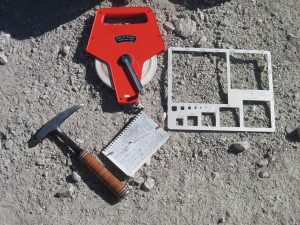These first few weeks of the internship were very exciting. I am still in a state of disbelief over being selected for this incredible opportunity.
I have learned the basics of programming code using a language called Python and read several papers on fluvial geomorphology. My project focuses on determining how three different processes affect downstream fining of fluvial sediment grains. The processes are hill supply, which are the grains provided by land adjacent to a channel, selective transport, which simply means that smaller grains are transported further than large ones, and abrasion, which is the physical weathering that happens when grains collide. Each process causes fining-down of sediments.
My question is to what degree does each of these processes affect sediment grain size? Yesterday was my first day conducting field research at Chalk Creek, Colorado and it was awesome! My mentor, Charlie Shobe, has been extremely helpful and getting a good start on my project felt great. I used a gravelometer to measure 200 sediment grain samples along an alluvial fan that flows perpendicularly into Chalk Creek. I have been working on analyzing my data using Excel and Python. Working outside was really fun and organizing data that I collected myself was very satisfying. Here at the end of the third week I am feeling confident about my project but know that I still have much to accomplish.


Taylor, you have explained your project quite well. I have actually used a gravimeter, so I know what it is. But most people don’t know what it is, so it’s great to have a picture of all the tools you are using. Sounds like you are picking up lots of skills – both field and programming.
It’s so cool that you have been able to learn Python and actually have used it for your project! Also you did a great job describing your project, can’t wait to see the final presentation!